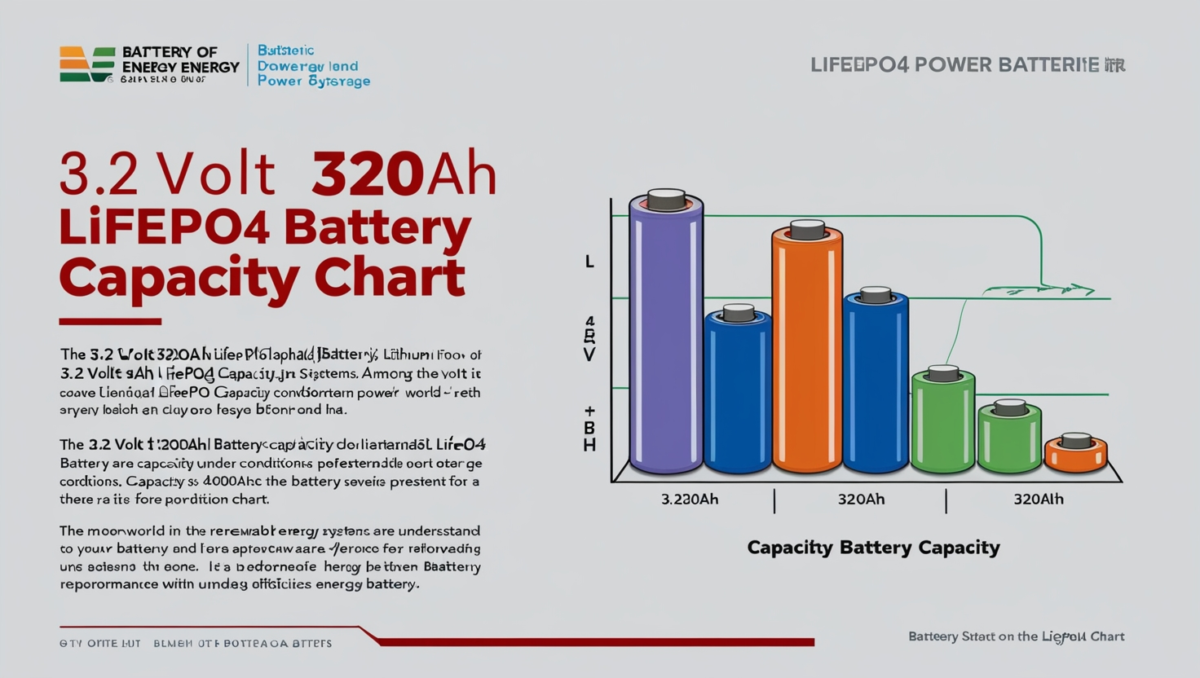
Introduction:
In the modern world of renewable energy storage and electric power systems, lithium iron phosphate (LiFePO4) batteries are a cornerstone of innovation. Among the vast array of battery options, the 3.2 volt 320Ah LiFePO4 battery stands out for its efficiency, longevity, and reliability. The 3.2 volt 320Ah LiFePO4 battery capacity chart serves as a critical tool for users to understand and optimize battery performance under various conditions. In this article, we will delve into the intricacies of this capacity chart, exploring how it reflects the battery’s potential and practical uses.
The Basics of LiFePO4 Batteries
LiFePO4 batteries, a specific type of lithium-ion battery, are renowned for their superior safety and long lifespan. Unlike other lithium-based chemistries, LiFePO4 batteries have a stable chemical structure, which makes them less prone to overheating or thermal runaway. The 3.2 Volt 320Ah LiFePO4 Battery Capacity Chart battery is designed to balance high energy density and robust durability, making it ideal for maritime systems, electric cars, and solar energy storage applications.
Why Capacity Charts Are Crucial
A battery’s capacity chart is more than just a table of numbers; it’s a roadmap for understanding how the battery performs under different conditions. The 3.2 volt 320Ah LiFePO4 battery capacity chart is an essential reference for gauging how much energy the battery can store and deliver over time. It includes detailed data on parameters such as discharge rates, temperature effects, and depth of discharge, all of which influence the battery’s overall efficiency and longevity.
Key Components of the 3.2 Volt 320Ah LiFePO4 Battery Capacity Chart
Discharge Rates and Capacity Retention
One of the primary aspects of the 3.2 volt 320Ah LiFePO4 battery capacity chart is the relationship between discharge rates and capacity retention. Its maximum capacity is 320Ah at lower discharge rates. However, at higher discharge rates, the capacity slightly decreases due to increased internal resistance and heat generation. This chart enables users to choose appropriate discharge rates to maximize battery life and efficiency.
Temperature Influence
LiFePO4 battery performance is significantly impacted by temperature.. The 3.2 volt 320Ah LiFePO4 battery capacity chart highlights how capacity fluctuates with varying temperatures. For instance, the battery performs optimally between 15°C and 35°C. At lower temperatures, capacity decreases as chemical reactions slow, while extremely high temperatures can accelerate wear and reduce lifespan.
Depth of Discharge (DoD)
Another critical factor is the depth of discharge (DoD), or the percentage of a battery’s capacity that is used before recharging. The 3.2 volt 320Ah LiFePO4 battery capacity chart typically indicates that maintaining a lower DoD, such as 80%, can significantly extend the battery’s cycle life. Conversely, deep discharges close to 100% may reduce the battery’s overall lifespan.
Applications of the 3.2 Volt 320Ah LiFePO4 Battery
Renewable Energy Systems
The 3.2 volt 320Ah LiFePO4 battery capacity chart helps system designers and operators determine the ideal battery configurations in solar and wind energy storage systems. By analyzing the chart, they can predict how long the battery can support a load during low production periods, ensuring a consistent energy supply.
Electric Vehicles (EVs)
The 3.2 volt 320Ah LiFePO4 battery capacity chart offers insights into range expectations and charging strategies for EV manufacturers and users. The data on discharge rates and temperature influence helps optimize the battery for real-world driving conditions, balancing power delivery with longevity.
Off-Grid and Backup Power
Understanding the 3.2 volt 320Ah LiFePO4 battery capacity chart is crucial for planning power usage in off-grid setups or emergency backup systems. The chart ensures that users can rely on their batteries for extended periods without risking over-discharge or system failure.
Maintenance and Optimization Using the Capacity Chart
Proper maintenance and use of the 3.2 volt 320Ah LiFePO4 battery rely heavily on the insights provided by its capacity chart. Regular monitoring of discharge rates, operating temperatures, and DoD can prevent unnecessary strain on the battery, ensuring it delivers peak performance for years. Additionally, users can identify early signs of degradation by comparing actual performance against the chart’s predictions.
Future Trends and Advancements
As LiFePO4 technology evolves, capacity charts for batteries like the 3.2-volt 320Ah model become even more detailed and precise. Advanced monitoring and intelligent battery management systems (BMS) now integrate these charts with real-time data to offer dynamic insights. This trend promises to make the 3.2 volt 320Ah LiFePO4 battery capacity chart an even more powerful tool for maximizing energy efficiency.
Conclusion
The 3.2 volt 320Ah LiFePO4 battery capacity chart is an indispensable resource for anyone utilizing these batteries in their energy systems. Users can ensure optimal performance and longevity by understanding the factors that influence battery capacity—such as discharge rates, temperature, and depth of discharge. This chart provides the clarity needed to make informed decisions, from renewable energy storage to electric vehicles. As the demand for reliable and efficient energy storage grows, the role of the 3.2 volt 320Ah LiFePO4 battery and its capacity chart will only become more significant, guiding users toward more intelligent energy management solutions.



